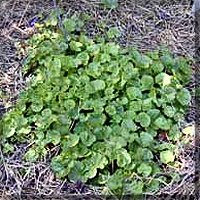

Centella asiatica


Centella asiatica
Origin - Madagascar (wild)
Other Names - Bramhi, Hydrocotyle asiatica, Indian Pennywort, Marsh Penny, coinwort, Asiatic coinwort, American coinwortPart of the plant used - Aerial part
Description - Asiatic coinwort appears to have originated in the wetlands of Asia. China, India, and Malaya were probably within its original range. It apparently spread through the South Pacific and to Mauritius, Madagascar, East and South Afrika, Turkey, and the southeastern United States many centuries (or perhaps millennia) ago. Asiatic coinwort is a small creeping herb with shovel shaped leaves emerging alternately in clusters at the stem nodes. The runners lie along the ground and the inch long leaves with their scalloped edges rise above on long reddish petioles. The insignificant greenish - to pinkish- white flowers are borne in dense umbels (clusters in which all thes talks arise from the same point) on separate stems in the summer. The seeds are pumpkin-shaped nutlets 0.1-0.2 in (3-5 mm) long.
Pharmacology - Centella is actually a specific variety of gotu kola, but since no other varieties possess such high amounts of asiaticosides and other triterpenes, the term "centella" is reserved for just this variety; "gotu kola" is used for all other varieties. Centella is found only in Madagascar while the other varieties of gotu kola are found in India and neighboring countries. Centella does not contain caffeine or any derivatives. Asiaticosides stimulate the reticuloendothelial system where new blood cells are formed and old ones destroyed, fatty materials are stored, iron is metabolized and immune responses and inflammation occur or begin. The primary mode of action of Centella appears to be on the various phases of connective tissue development, which are part of the healing process. Centella also increases keratinization, the process of building more skin in areas of infection such as sores and ulcers. Asiaticosides also stimulate the synthesis of lipids and proteins necessary for healthy skin. Finally, Centella strengthens veins by repairing the connective tissues surrounding veins and decreasing capillary fragility.
Historical Uses - The study of nutritional support for wound healing reveals that Centella asiatica and Aloe vera have been used for decades, both topically and internally, to enhance wound repair.C entella asiatica extract is used effectively for keloids, leg ulcers, phlebitis, slow-healing wounds, leprosy, surgical lesions, striae distensae and cellulitis. Although applied to damaged skin, the risk of contact sensitivity to it is low.
Medicinal Uses - Centella has been found to have important healing effects on solid tissues, including skin, connective tissues, lymph tissues, blood vessels, and mucous membranes. Centella has found its most successful applications in treatment of conditions involving venous insufficiency, tissue inflammation and infection and post-surgical healing. A number of Thai medicinal plants including Centella asiatica extracts which contains asiaticoside, were investigated for their intracellular activities against herpes simplex viruses by plaque inhibition assay and shown to have inhibitory effects on tested virus
Dosages - Herbal tea infusion - The standard way to make an infusion, unless otherwise specified, is to pour a cup of boiling water over the material to be infused, let it stand for 5 minutes, strain it, and drink it.
Contra-indcations - do not use during pregnancy or during breast feeding. Consuming high doses of gotu kola can cause nausea, dizziness, and sedation, individuals should refrain from taking this herb with medications that promote sleep or reduce anxiety.